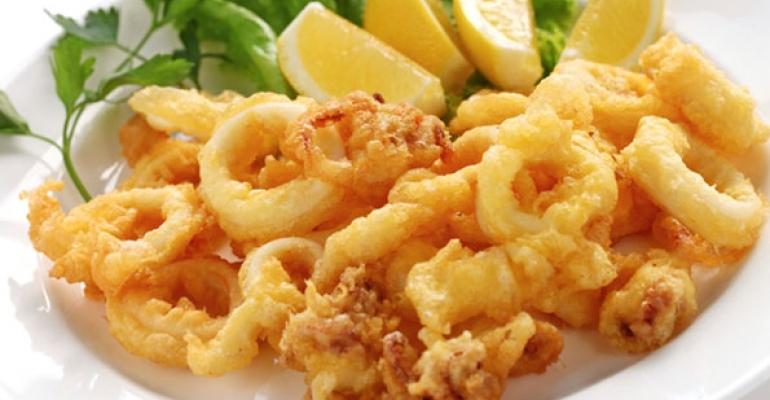In case you didn’t hear, according to the New York Times, calamari is so 1996. At least that’s when the term experienced peak mentions in the paper. In 2013, it was only mentioned a paltry 19 times. That hardly stacks up to the 216 mentions that kale accrued in the same year. And if you believe that what newspapers are talking about is an accurate reflection of what people are eating, then by that logic, you might assume that kale easily trumps calamari in mentions on menus as well.
But that is not the case in reality. Kale is currently mentioned on 2 percent of menus across the country, while calamari appears on 35 percent of menus. If you adjust some of the inputs to account for the likelihood that independent and expensive operators are more likely to menu new food trends quickly, that percentage drops even further to 1 percent. The surprising takeaway here is that if you are a foodservice operator or manufacturer, you might be better off menuing calamari or manufacturing and selling calamari-related items (ie: cocktail sauce) than you would kale or kale-related products, despite the New York Times declaring calamari a food trend of a bygone era.
The article does rightly point out that after trendy food items like calamari peak, they don’t just disappear. Rather, some of them are folded into the mainstream and become so ubiquitous every airport Chili’s on the eastern seaboard now offers calamari as an appetizer. At least, that’s what many food trends of the past did. According to the author, the same cannot yet be said for newer, trendy food items. About them he writes, “They now appear to become more popular faster, and then to fade from glory. For example, tuna tartare, [...], first took off in 1994, before peaking in 2000.” Press around tuna tartare has since tapered off, implying that it’s initial buzz did not translate into a lot of real world activity that in turn would’ve kept it in the news.
RELATED
• 5 hot summer food and beverage trends
• A look at the summer burger boom
• More food and beverage news
The point is, the amount of press a food item attracts is not a metric worth considering if you are a large-scale foodservice operator or manufacturer. Sometimes, as was the case with calamari, it might correlate with an increase in actual menu mentions and consumer awareness. Other times, as was the case with tuna tartare, it might not.
Another element of the Times article that’s worth addressing is the actual pace of a trendy food’s ascension. This article concludes that, “For our trendy foods of a generation ago, it took an average of nearly 24 years to go from the time they first started trending to the time their coverage peaked. For our recent trendy foods, that’s 10.4 years.” Put another way: Calamari took a tortoise’s pace to the top, while kale ascended more like a hare, reaching its peak mentions in 11 years as opposed to calamari’s 16 years. This makes sense. Here at Food Genius, we’ve frequently discussed how the Internet has increased the speed at which foods become trendy. What still isn’t known is if this increased speed in online mention ascension translates to an increased speed in menu mention growth or revenue growth for the companies that take advantage of these trends right off the bat.

Does your restaurant embrace or shun trendy foods? Join the conversation in the comments below.
Kale’s New York Times mentions grew at a rate of 20 mentions per year. Unfortunately our data doesn’t date back eleven years so we can’t be sure of how the rate of kale menu mentions compares with the rate of kale online mentions, but we will let you know come 2025. Our prediction is that kale’s menu mentions will grow at a much slower annual rate than its online mentions did overall. Until we can know for sure, there is so much more valuable data that operators can and should be observing.
Instead of worrying about kale, wait to see how relevant it becomes not to the New York Times, but to the everyday consumer. And in the meantime, do think about calamari because it has already been established as a likable food by the masses. To that end, here are two actionable insights that could affect the way you menu or sell calamari and calamari-related products today.
1. Calamari is almost four times as likely to appear on a menu in the Northeast region of the United States than it is in the South Central region. (Cocktail sauce manufacturers: Are your sales teams targeting the right regions to push your product?)
2. Hawaii is the state with the most expensive average menu price of calamari at $13.42. (Hey, Hawaii restaurant operators, are you underpricing your calamari?)
This kind of nuanced analysis and content will never go viral, but it will affect your bottom line. The trends that would benefit foodservice operators and manufacturers aren’t the ones measured by press mentions; they are the ones measured by menu mentions.

